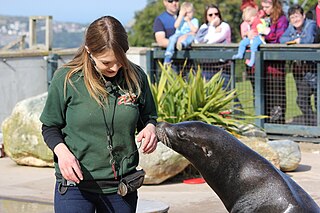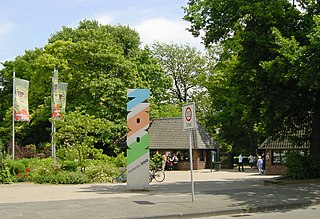
The okapi, also known as the forest giraffe, Congolese giraffe and zebra giraffe, is an artiodactyl mammal that is endemic to the northeast Democratic Republic of the Congo in central Africa. However, non-invasive genetic identification has suggested that a population has occurred south-west of the Congo River as well. It is the only species in the genus Okapia. Although the okapi has striped markings reminiscent of zebras, it is most closely related to the giraffe. The okapi and the giraffe are the only living members of the family Giraffidae.

Hanover Zoo is located in the city centre, or Mitte borough, of Hanover, Germany. The zoo was established on 4 May 1865, and comprises an area of 22 hectares. It contains about 3,414 animals in 237 species, which are cared for by more than 400 employees in the summer season.

Schönbrunn Zoo is a 17-hectare (42-acre) zoo in the city of Vienna, Austria. Established in 1752, it is the world's oldest zoo still in operation. It is also a UNESCO World Heritage Site, being a part of the Schönbrunn Palace gardens. It generally receives more than 2 million visitors every year.

Hellabrunn Zoo is a 40 hectare zoological garden in the Bavarian capital of Munich. The zoo is situated on the right bank of the river Isar, in the southern part of Munich near the quarter of Thalkirchen.

The Berlin Zoological Garden is the oldest surviving and best-known zoo in Germany. Opened in 1844, it covers 35 hectares and is located in Berlin's Tiergarten. With about 1,380 different species and over 20,200 animals, the zoo presents one of the most comprehensive collections of species in the world.

The Aktiengesellschaft Cologne Zoological Garden is the zoo of Cologne, Germany. Being the third oldest zoo in Germany, it features over 10,000 animals of more than 850 species on more than 20 hectares. The internationally renowned zoo with an attached aquarium and invertebrate exhibit is active in preservational breeding of animals that are in danger of becoming extinct. In addition, in-the-wild conservation efforts and research focussing on animals of Madagascar, Wallacea, and Vietnam are actively promoted and supported via cooperation with Cologne University and local projects, such as in the case of Przewalski's horses.
Zoo Landau in der Pfalz is a 4-hectare (9.9-acre) zoo in Landau in der Pfalz, Germany. It was founded in 1904. The governing body is the municipality of the city of Landau in der Pfalz (Landau/Palatinate/Germany). The zoo is situated in the city center, along the historic remains of a French fort. The average yearly number of paying visitors is between 155,000 and 170,000. The zoo is home to about 600 animals representing 110 species of mammals, birds, reptiles, amphibians, fish, and invertebrates. The current total number of employees is 20.

The Bornean bearded pig, also known as the Sunda bearded pig or simply bearded pig, is a species in the pig genus, Sus.

A zoo is a facility in which animals are kept within enclosures for public exhibition and often bred for conservation purposes.

Zoo Basel is a non-profit zoo in the city of Basel, Switzerland. Its official name is Zoologischer Garten Basel — or in English: Basel Zoological Garden. Basel residents affectionately call it Zolli. Its main entrance is just outside Basel's downtown strip of Steinen-Vorstadt and extends in the Birsig stream valley to Basel's city border with Binningen, Basel-Country. The zoo has over 500 animal species from all seven continents.

Dresden Zoo, or Zoo Dresden, is a zoo in the city of Dresden, Germany. It was opened in 1861, making it Germany's fourth oldest zoo. It was originally designed by Peter Joseph Lenné.

An exotic pet is a pet which is relatively rare or unusual to keep, or is generally thought of as a wild species rather than as a domesticated pet. The definition varies by culture, location, and over time—as animals become firmly enough established in the world of animal fancy, they may no longer be considered exotic.

Slottskogens djurpark is a Swedish zoo in the park Slottsskogen, located in the town of Gothenburg in Sweden. It is a member of the European Association of Zoos and Aquaria (EAZA).

Augsburg Zoo is a zoo located in the city of Augsburg in Bavaria, Germany, and with over 600,000 visitors annually, the zoo belongs to the 20 largest Zoos in Germany.

Krefeld Zoo is a zoo in the city of Krefeld, Germany, specialized in management of primates, carnivores, fauna from the African savanna and tropical birds.

The Kaiserslautern Zoo is a zoo in the city of Kaiserslautern in Germany. The Zoo was founded on 15 June 1968 and is located in Kaiserslautern's Siegelbach neighbourhood. The zoo originally belonged to the town of Siegelbach which became part of the city in 1969.

Magdeburg Zoo is a zoo in the city of Magdeburg in the region Sachsen-Anhalt, Germany. The zoo was founded in 1950, and covers 16 hectares.

The Saarbrücken Zoo is with over 200.000 visitors annually, and over 1.700 animals from 160 Species the largest Zoo in Saarland. The Zoo is specialized in African animals.

The Chemnitz Zoo is a zoo in the city Chemnitz in Sachsen, Germany.

The Görlitz Zoo is a zoo in Görlitz, in Saxony, Germany.




















